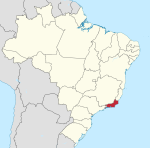Gamboa, Rio de Janeiro
Gamboa is a neighborhood in Rio de Janeiro, Brazil. Gamboa, along with Santo Cristo and Saúde, is one of the oldest boroughs of Rio. It was originally settled by the aristocracy, due to the attractive position on the shores of Guanabara Bay, but lost its glamour when the docks were built. Along with this history, the area also hosts The English Cemetery at Gamboa, one of the oldest British institutions in Rio. In 1809, Dom João VI ceded to the British two and a half acres of farmland along the shore of the bay. Lord Strangford, British Ambassador to the Emperor's court, founded the cemetery, and the first burial took place in 1811.
Excerpt from the Wikipedia article Gamboa, Rio de Janeiro (License: CC BY-SA 3.0, Authors).Gamboa, Rio de Janeiro
Rua do Livramento, Rio de Janeiro Gamboa (Zona Central do Rio de Janeiro)
Geographical coordinates (GPS) Address Nearby Places Show on map
Geographical coordinates (GPS)
| Latitude | Longitude |
|---|---|
| N -22.8975 ° | E -43.192777777778 ° |
Address
Rua do Livramento
Rua do Livramento
20081-250 Rio de Janeiro, Gamboa (Zona Central do Rio de Janeiro)
Rio de Janeiro, Brazil
Open on Google Maps










